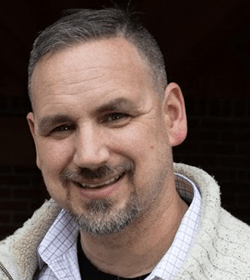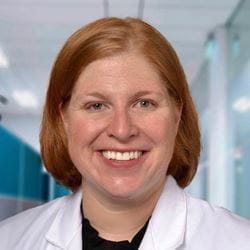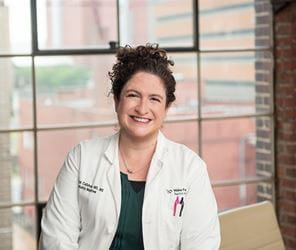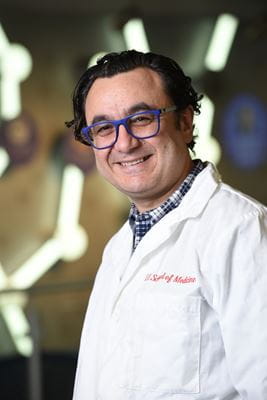IU Center for Health Innovation and Implementation Science trains leaders to make immediate improvements in health care delivery
Often, a scientific discovery is announced with great excitement, but it fails to impact real patient lives for another 17 years, on average. Implementation of medical innovation is historically slow, and that’s unacceptable in today’s health care environment, said Malaz Boustani, MD, MPH, a geriatrician, neuroscientist and implementation scientist who is the founding director of the Center for Health Innovation and Implementation Science (CHIIS) at Indiana University School of Medicine.
“Medicine needs implementation science to optimize the discovery-to-delivery translation cycle, thus making positive impacts at the individual, family and societal levels,” Boustani said. “We have been on the journey of taking research off the bookshelves and implementing evidence-based practices within our partner delivery systems for a decade.”
 In 2015, the first cohort of health care professionals engaged in the CHIIS’s Innovation and Implementation Science Graduate Certificate Program, funded by IU School of Medicine and the Indiana Clinical and Translational Sciences Institute (CTSI). The program’s goal is to transform health care leaders into “agile change conductors” capable of designing, implementing and diffusing evidence-based care solutions within their health care systems.
In 2015, the first cohort of health care professionals engaged in the CHIIS’s Innovation and Implementation Science Graduate Certificate Program, funded by IU School of Medicine and the Indiana Clinical and Translational Sciences Institute (CTSI). The program’s goal is to transform health care leaders into “agile change conductors” capable of designing, implementing and diffusing evidence-based care solutions within their health care systems.
Christopher Williams, PhD, MBA, was part of that first cohort. He was closing out a military career in health care administration and is now an operational excellence consultant at Eskenazi Health. Williams previously completed training in project management strategies from the business world like Lean and Six Sigma, but he was looking for additional people management tools. “The program allowed us to work alongside very smart and dynamic leaders in the industry,” he said. “This program teaches you how to solve problems with the biggest variable in any project, and that is humans.”
How agile science improves health care
Frontier Public Health recently published results from a survey including 52 of the program’s 60 alumni to date. Graduates agree the certificate benefitted their careers, expanded their professional network and had a large impact on the effectiveness of their leadership, change management and communication.
 “I apply agile science to everything I do now,” said Carmen Quatman, MD, PhD, a 2022 graduate who is an orthopedic surgeon specializing in trauma and geriatric care at The Ohio State University Wexner Medical Center. “The change of focus is rapid implementation. Rather than waiting for a process to unfold, I use nudges and strategies to implement it faster.”
“I apply agile science to everything I do now,” said Carmen Quatman, MD, PhD, a 2022 graduate who is an orthopedic surgeon specializing in trauma and geriatric care at The Ohio State University Wexner Medical Center. “The change of focus is rapid implementation. Rather than waiting for a process to unfold, I use nudges and strategies to implement it faster.”
Practically speaking, this might look like pivoting a surgical strategy in the operating room. Or, it could mean setting a timer and creating space for daily self-reflection, which is critical to innovation.
While a large portion of the program’s participants are physicians, anyone in health care is invited to participate. Past cohorts have included nurses, masters-level administrators, social workers and other clinically-trained personnel representing health systems throughout the nation. Group discussions are enhanced by the diversity of participants—60 percent of graduates are female, and 30 percent come from underrepresented minority populations.
In Quatman’s cohort, ages ranged from a hospital leader with 30 years of health care experience to an 18-year-old high school student who helped as a teaching assistant. It also included an individual who immigrated to the United States as a child and gained legal status through the Deferred Action for Childhood Arrivals (DACA) policy.
“It was a really diverse cohort of different people from different backgrounds engaging in deep sharing; it was incredibly unique,” Quatman said. “The sharing of vulnerability in my cohort allowed us, even in a virtual space, to elevate our social network and social intelligence at a level to make us true change agents.”
 “It’s a bonding thing—others who speak the same language of change conductors,” added 2020 graduate Kathryn Callahan, MD, MS, a geriatrician and healthy systems researcher at Wake Forest University School of Medicine.
“It’s a bonding thing—others who speak the same language of change conductors,” added 2020 graduate Kathryn Callahan, MD, MS, a geriatrician and healthy systems researcher at Wake Forest University School of Medicine.
Callahan said the program helped her develop confidence as a decision maker by learning how change begins and how it can be sustained. She used her implementation science training to develop and test a de-prescribing pathway for older adults with diabetes.
Heidi Lindroth, PhD, RN, a nurse scientist with Mayo Clinic, said she now has a “full toolbox” to draw from as she develops and implements evidence-based strategies to help curb the distress delirium causes for patients, families and clinicians.
 “We have evidence to stop delirium, and my training in implementation science has given me the tools I need to move evidence into practice,” she said.
“We have evidence to stop delirium, and my training in implementation science has given me the tools I need to move evidence into practice,” she said.
One of her biggest takeaways from the certification program was not to fear failure.
“Failing is the only way to learn,” Lindroth said. “And that is key if we are going to change our health care system.”
Williams puts it this way: “This method allows for our team to fail fast but learn very quickly the best way to move forward.”
 At Eskenazi Health in Indianapolis, where Boustani is director of care innovation, implementation science was the tool behind an evidence-based collaborative care model for patients with dementia or depression.
At Eskenazi Health in Indianapolis, where Boustani is director of care innovation, implementation science was the tool behind an evidence-based collaborative care model for patients with dementia or depression.
“The model was able to reduce the patients’ behavioral and psychological symptoms, decrease and prevent their family caregiver burden, keep the patients at home and save more than $3,500 per family per year,” Boustani reported. “We now are expanding the collaborative care model into other vulnerable populations, such as those who survived intensive care units, surgical trauma and emergency surgery.”
Alumni of the CHIIS certification program enthusiastically recommend it to colleagues. Many also return as speakers for the next cohorts enhancing their strategic toolkits through implementation science.
“I recommend the certificate program because it provides the tools, strategies and skills needed to become a transformational leader who is able to readily implement change into clinical practice so that the evidence we have to improve patient care is used,” Lindroth said.
